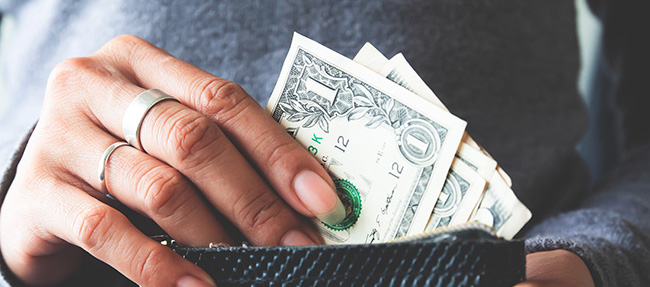••• social media research
Too much or not enough?
Opinions of tech company regulations differ with ideology
 A majority of Americans think social media companies have too much power and influence in politics and roughly half think major technology companies should be regulated more than they are now, according to a new Pew Research Center survey as reported by Pew’s Monica Anderson.
A majority of Americans think social media companies have too much power and influence in politics and roughly half think major technology companies should be regulated more than they are now, according to a new Pew Research Center survey as reported by Pew’s Monica Anderson.
Overall, 72% of U.S. adults say social media companies have too much power and influence in politics today. Far fewer Americans believe the amount of political power these companies hold is about the right amount (21%) or not enough (6%). Majorities of both Republicans and Democrats believe social media companies wield too much power but Republicans are particularly likely to express this view. Roughly eight in 10 Republicans and Republican-leaning independents (82%) think these companies have too much power and influence in politics, compared with 63% of Democrats and Democrat-leaners. Democrats, on the other hand, are more likely than Republicans to say these companies have about the right amount of power and influence in politics (28% vs. 13%). Small shares in both parties believe these companies do not have enough power.
The survey found some ideological differences within the parties. About nine in 10 conservative Republicans (89%) think these companies have too much power, versus 74% of moderate or liberal Republicans. And liberal Democrats are somewhat more likely than moderate or conservative Democrats to agree with this assessment (68% vs. 60%).
Amid recent concerns about fair practices among tech companies, Americans favor more regulation of major technology companies; 47% of the public thinks the government should be regulating major technology companies more than they are now, while just 11% think they should be regulated less. About four in 10 (39%) believe regulation should stay at its current level.
Similar shares of Republicans (48%) and Democrats (46%) agree that the government should regulate big technology companies more than is currently the case. Democratic support for increased regulation has dropped 11 percentage points since 2018 – by comparison, Republicans’ views overall on the issue are about the same today as they were two years ago.
However, ideology is also a factor. The share of conservative Republicans who believe these companies should face more government regulation has increased from 42% to 53% since 2018. At the same time, the share of liberal Democrats who support more regulation of big technology firms has fallen from 65% to 52%. Conservative Republicans are the only ideological group who have become more likely to favor increased regulation.
Moderate or liberal Republicans and moderate or conservative Democrats tend to hold similar views about regulating the tech industry. Today, 42% in each group say there should be more regulation of major tech companies, down from 55% since 2018 among moderate or liberal Republicans and 54% among moderate or conservative Democrats.
The study was conducted by Pew Research Center among U.S. adults from June 16-22, 2020.
••• generational research
COVID-19 fuels tech use among seniors
Telemedicine is trending
A recent study by healthinsurance.com polled Medicare-eligible respondents ages 64 and older to learn how they’re embracing technology, particularly in the time of COVID-19.
The coronavirus pandemic is affecting seniors’ daily habits and family life; 38% haven’t seen their kids or grandkids in person since mid-March. More than half have put off a dentist appointment because of COVID-19. Six in 10 have only left the house to go food shopping or to the pharmacy. On the flip side, 27% say they have left their house whenever they wanted during the pandemic.
 A particular increase in tech use among seniors sprung from the need to meet health care needs during the pandemic. Telemedicine usage has increased by 340% among Medicare recipients since the start of COVID-19. One-third report ordering their prescriptions from an online pharmacy. And tech use for health care reasons extends beyond telemedicine and the internet – nearly one-third of respondents say they monitor their health using a wearable. In fact, four in 10 are interested in a wearable that helps them and those around them maintain appropriate social distance.
A particular increase in tech use among seniors sprung from the need to meet health care needs during the pandemic. Telemedicine usage has increased by 340% among Medicare recipients since the start of COVID-19. One-third report ordering their prescriptions from an online pharmacy. And tech use for health care reasons extends beyond telemedicine and the internet – nearly one-third of respondents say they monitor their health using a wearable. In fact, four in 10 are interested in a wearable that helps them and those around them maintain appropriate social distance.
Telemedicine is trending among those on Medicare. Prior to COVID-19 only one in 10 used telemedicine. During COVID-19, 44% have used telemedicine and 43% say they intend on using it after. Of those who used telemedicine, 58% say they have used it just once and 30% report using it once a month. Two-thirds of those who haven’t tried telemedicine said the reason is simply because they haven’t needed the service.
Seniors are staying connected with social networks via technology; 73% are on social media with 83% saying they use Facebook the most. Fifty-two percent say they use social media to stay in touch with family and friends and 21% say they use it to get news.
The usage of video chatting services has risen among this group during the pandemic as well. More than half video chat with their kids and grandkids at least once a month, with 50% saying they video chat more since the start of COVID-19. And it’s not just with family – 32% say they video chat with their friends as well.
While 66% of seniors aren’t completely sold on cutting cable TV, 75% of respondents say they have a smart TV or use a streaming device, with 47% admitting to binge-watching. And seniors are embracing smartphones as well, with nine in 10 respondents saying they have a smartphone and like to use it. Seventy-one percent say their preferred method of communication is either texting or talking on their cell phone. And it’s not just smartphones – two-thirds say they also have some type of tablet. Eleven percent have used the COVID-19 pandemic as a reason to start using a smartphone.
The study was conducted by healthinsurance.com and polled more than 1,000 Medicare-eligible U.S. respondents aged 64+. The study was fielded from July 17-20, 2020.
••• employee research
What does the future hold?
COVID-19 is causing workers to rethink their careers
 In its recent study, Understanding Workplace Sentiment During COVID-19, DeVry University looked at how American employees understand their careers during the current crisis. Not surprisingly, many people are rethinking their work and life priorities – according to the study, one in four respondents said they were thinking of changing careers due to COVID-19, with 38% citing a desire to work from home or better work/life balance as their top motivations. Other reasons for rethinking careers due to COVID-19 included job security (13%) and less exposure to illness (8%).
In its recent study, Understanding Workplace Sentiment During COVID-19, DeVry University looked at how American employees understand their careers during the current crisis. Not surprisingly, many people are rethinking their work and life priorities – according to the study, one in four respondents said they were thinking of changing careers due to COVID-19, with 38% citing a desire to work from home or better work/life balance as their top motivations. Other reasons for rethinking careers due to COVID-19 included job security (13%) and less exposure to illness (8%).
Of those who were employed, 31% were concerned a lack of either hard skills or certifications made them vulnerable to layoffs or would challenge their ability to find new employment. Respondents were almost equally worried about a lack of soft skills or network, with 27% citing these areas of concern. Interestingly, almost half (49%) reported they have no personal weaknesses of concern; they are confident in their capabilities as they relate to keeping or finding a job.
Similarly, 39% of respondents, who were currently working or intending to find work, do not plan on doing anything to boost their confidence in their current career. For the nearly 60% who are planning to take steps to increase their career confidence, the two most common plans included networking (23%), with more men (27%) than women (17%) planning to network, and continuing education (45%), with almost half planning to continue their education by obtaining a certificate, finishing or starting a degree, or pursuing a higher credential (approximately 11% in each subcategory). Very few (11%) planned to seek advice from their current employers, which could indicate a lack of trust or anticipated resources.
The survey was conducted by Engine Insights on behalf of DeVry University and polled 1,004 U.S. adults from April 29-May 1, 2020.

••• consumer psychology
Voting with their pocketbooks
The practice of boycotting is increasing – and conflicting
A substantial percentage of consumers who feel that a company is behaving wrongly are willing to express their disapproval by withholding their dollars, according to a report by CompareCards which found that 38% of Americans – and more than half of Gen Z and Millennials – are currently boycotting at least one company. The number of boycotting consumers is up from 26% in January 2019.
The coronavirus pandemic, coupled with recent protests against social injustice, has caused many consumers to scrutinize the way a company operates and change their spending habits accordingly, from shunning businesses who don’t treat their employees fairly to prioritizing the purchasing of Black-owned brands.
Nearly a quarter (23%) of boycotting consumers said the company they’re refusing to patronize has been accused of racism. A similar number of consumers said the diversity of a company’s executive suite factors into their decision to spend money with that company.
The Black Lives Matter movement and mask requirement create nearly an even split among many boycotting consumers. Nineteen percent of boycotting consumers are refusing to spend money with a company due to its support for the Black Lives Matter movement, while 18% are boycotting companies that do not support the movement. At the same time, 16% are withholding dollars from businesses that don’t require shoppers to wear masks but 15% are boycotting places that do require patrons to don face coverings.
The study found that the likelihood of someone boycotting a company decreased with age. About half of Gen Z (51%) and Millennials (52%) are currently boycotting at least one company but that number drops slightly for Gen X (37%) and greatly for Baby Boomers (22%) and the Silent Generation (16%).
More than half (53%) of Americans said they’re more likely to buy from a company that gives to charities or is associated with causes they believe in. And 41% said they would cut ties with their favorite retailer if it publicly supported something or someone they strongly disagreed with.
The study was conducted by Qualtrics on behalf of CompareCards and surveyed 1,026 Americans from July 10-13, 2020.
••• small business research
Business unusual
SBOs expect future decreased revenue
 In its Small Business Recovery Survey, TD Bank polled 750 small businesses across the U.S. to understand how small business owners (SBOs) are handling the challenges created by the pandemic. More than half (58%) of SBOs report that they expect their revenue to decrease in 2020, even though 47% stated they did not have to close for any amount of time during the COVID-19 pandemic. Conversely, just 16% of SBOs expect to see any increase in revenue in 2020, while 26% project it will stay the same.
In its Small Business Recovery Survey, TD Bank polled 750 small businesses across the U.S. to understand how small business owners (SBOs) are handling the challenges created by the pandemic. More than half (58%) of SBOs report that they expect their revenue to decrease in 2020, even though 47% stated they did not have to close for any amount of time during the COVID-19 pandemic. Conversely, just 16% of SBOs expect to see any increase in revenue in 2020, while 26% project it will stay the same.
The TD Bank Small Business Recovery Survey polled businesses with less than $10 million in annual revenue and 250 or fewer employees. Businesses with annual revenues of $500,000 or less, which comprised 59% of the survey respondents, were more likely than those with higher annual revenues to state that they expect significant 2020 revenue decreases (loss of 10% or more), with 38% of this group making such projections.
Many SBOs have sought assistance. Forty-three percent of survey respondents participated in the Small Business Administration’s Paycheck Protection Program (PPP). Of those businesses in the survey that received a PPP loan, 60% have annual revenues of $1 million or less.
Small businesses were ill-equipped to cope with the challenges of COVID-19, according to the survey. Eighty-one percent of SBOs said they did not have a disaster or crisis plan prior to pandemic shutdowns. Further, 31% of respondents did not make any changes to business operations or strategy to adapt to the circumstances. Of the 69% of SBOs that reported implementing one or more changes, 28% added work from home capabilities, 27% reduced operating hours, 20% temporarily or permanently laid off staff, 18% incurred extra costs for additional cleaning and 13% moved their business online.
What’s more, only half of respondents reported making any business adjustments to better serve their customers or clientele, although Millennial and Gen Z business owners (ages 18-39) were nearly twice as likely as Gen X and baby boomer SBOs to make changes to accommodate customers during this time. SBOs who did modify operations for their customers added virtual functions like appointments/telehealth or conferences (25%); created a new delivery or pick-up service (15%); and developed e-commerce/online sales (11%).
SBOs had mixed feelings about their financial outlook and external factors that could affect their business operations. Fifty-five percent stated they will seek funding but just 7% of participants expressed concern about their ability to obtain a loan in the next year. When asked about top near-term challenges, 69% of SBOs pointed to the health of the economy, both national and local; 25% cited getting paid on time or without significant delays of more than 30 days; 24% considered the presidential election and potential regulatory changes; and 21% were worried about supply chain disruptions.
The study was conducted by Engine Insights on behalf of TD Bank and surveyed 750 small business owners in the U.S. from June 5-11, 2020.
••• travel research
On the road again – maybe
Consumers look forward to traveling once again, with some caveats
Not surprisingly, months of staying at home and altering behavior due to COVID-19 has given people the urge to get out and travel. In a recent survey by Oracle and Skift, just over half (51%) of respondents in both North and Latin America plan to book trips in the next six months, while 38% of those in Asia-Pacific and Europe are planning getaways. However, many people are opting to stay closer to home with trips within driving-distance (47%) or domestic trips (44%) being favored. With so much uncertainty ahead, consumers are also demanding flexible cancellation and refund policies (76%) and are more open to considering hotels offering discounted rates (65%).
Consumers’ willingness to travel also comes with caveats for hotels in terms of advancements in cleaning and technology. In response, 70% of hotels already are or are planning to adopt contactless technology for check-in, food ordering, concierge services and more. Ninety percent have or are planning to also increase cleaning and disinfecting frequency and training for staff on these procedures and safer guest interactions (89%).
With international border restriction and flying concerns, hotels will be welcoming new types of travelers, making the stakes high to leave a positive impression that will lead to repeat business and word-of-mouth recommendations. The survey found that border closures are reshaping the guest profile, with more than 30% of executives surveyed saying they expect to see a few more or significantly more domestic travelers and over 60% expect fewer or significantly fewer international travelers. This may work in favor of North American hoteliers, 57% of whom reported that the majority of their guests were domestic travelers before the health crisis, signaling a more limited impact on demand.

Hotels are moving swiftly to abide by consumer demands with more than 80% of executives reporting that they were considering or have already made changes to allow for more flexible cancellation and refund policies. Additionally, safety will be the new gold standard – unsurprisingly, space and cleanliness will remain critical, with 84% of travelers agreeing that “creating social distancing” rules for hotel public spaces will be the most influential factor in their decision about which travel brands to choose for upcoming trips. Hotel executives appear ready to meet these expectations, with 82% either considering or already altering public spaces to enable social distancing.
Technology is enabling social distancing and cleanliness by reducing the need for in-person interactions and empowering hotels to deliver service without contact. Specifically, more than 70% of executives said they were considering or are already using contactless payment and digital messaging services and close to 60% were considering/already using room keys activated by smartphone. Consumers concur, indicating that contactless payments (35%), digital room keys (26%) and digital messaging services (20%) were among the top three changes that would make them feel more comfortable staying in a hotel.
Over 70% of executives agreed or strongly agreed that self-service technology will be important to assisting guests while minimizing unnecessary contact, with two thirds (67%) reporting they were considering or are already using self-service check-in procedures. A similar portion of consumers (70%) agreed or strongly agreed they’d be more willing to stay at hospitality businesses that implemented these types of services, with 23% citing self-service check-in via kiosk as a change that would increase their comfort.
More than 60% of executive respondents reported they were considering or already making changes to expand room service options and 50% are looking into expanding meal takeout/delivery options. One-fifth of guests ranked expanded room service options as a top factor for alleviating concerns, allowing them to avoid shared spaces such as hotel restaurants.
The study was conducted by Oracle and Skift and surveyed more than 1,800 hospitality executives and 4,600 consumers across North America, Europe, Asia-Pacific and Latin America.out less in the next 12 months, most (54 percent) cite the need to save money as the primary reason for plans to cut back; however, the desire to eat healthier is a close second at 50 percent (also an increase of eight percentage points over the survey of March 2010).
Marketing channels and tactics are also a concern for restaurant companies moving forward. Despite movement over the past couple of years toward online marketing, only 20 percent of diners surveyed indicated that digital media influenced their dining-out decisions. For more information visit www.alixpartners.com.
